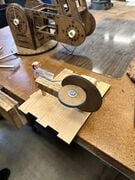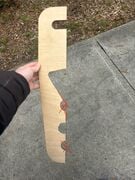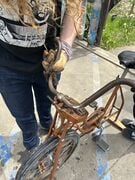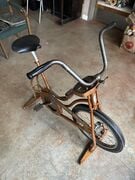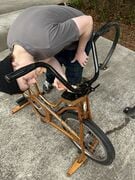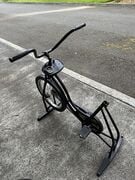
The CCAT 2024 pedal powered blender is a project completed during the spring semester of 2024. The project consists of a stationary bike mounted to a metal frame with a blender attached in front of it. The blender has a drive shaft and skateboard wheel that reaches down to the front bike wheel and is spun as the bike wheel also spins. The pedal powered blender is able to make smoothies in a manner that saves electricity while also teaching about mechanical power to those who come to CCAT.
Background[edit | edit source]
This project, the “Pedal Powered Blender,” aims to provide an educational opportunity about sustainability and mechanics. We are making this machine in collaboration with CCAT, a student run organization with goals of sustainability and education. Our team Animals on the Moon consisted of Engineering 205 students Jude Penny, Killian Soltero Walker, Kenny Lucero, and Thomas Martinez. Through this 2024 spring semester we plan on working with CCAT to create this Pedal Powered Blender.
Problem statement[edit | edit source]
The objective of this project is to create a pedal powered blender for CCAT using old restored parts of other projects so the people at CCAT can once again show off the use of pedal power. The bike and blender were provided for us but were quite deteriorated. The bike especially was covered in rust, though it was still fully operational. Other materials and supplies such as wood, power tools, and various cleaning supplies were also provided for us by CCAT or at the Forestry lab.
Criteria[edit | edit source]
The pedal powered blender has certain criteria and constraints that can be measured quantitatively. These criteria serve as further specifications and considerations for the design.
| Criteria | Description | Weight (1-10) |
|---|---|---|
| Performance | Able to be operated by one person | 10 |
| Durability | At least 5 years; preferably at least 10 years | 9 |
| Cost | Less than $500 | 8 |
| Aesthetics | Visually appealing/How much rust visible on the bike. | 8 |
| Portability | Can be stored in a small room (approximately 5’x4’x3’ volume) | 7 |
| Noise Level | Under 80dB | 6 |
Prototyping[edit | edit source]
Our prototype consisted of a small model designed to simulate the mechanical power of the bike and blender. Using this model, we were better able to understand how the pedal powered blender worked and why CCAT had chosen the design. By using the motion and friction of the wheels, a great deal of mechanical power is generated, which can sustainably power the blender. Additionally, we also did performance tests with the bike and blender to see how they performed and how to design a support system for the blender so that it stays in place while being operated. The resulting support system consisted of two identical but mirrored panels with holes cut out, designed to fit around the bike and blender and not take up too much space.
-
Model to simulate mechanical power
-
First panel cut out with annotations for redesigning
Final Product and Restoration[edit | edit source]
The support panels were redesigned to better fit around the bike and were also sanded down for safety. For the bike itself, a new seat was for the bike to replace the current seat. Additionally, the straps on the pedals, the brakes, and various components on the panel below the handlebars were also removed as these parts had no function or could be replaced with modern technology. Apart from that, much of the final design was more of a restoration project. The most time spent on restoration was rust removal. This was done using WD-40, steel wool, and wire brushes. Once as much rust as possible was removed, the bike was painted in a black enamel paint made specifically to prevent rust and to also cover up any remaining rust or other signs of deterioration.
-
Bike in process of rust removal
-
Bike cleaned of rust prior to painting
-
Bike in process of being painted
-
Bike fully painted
Bill of materials[edit | edit source]
Description of implementation costs
| Item | Amount | Cost per unit | Total |
|---|---|---|---|
| Steel Wool | 1 | USD 9.98 | USD 9.98 |
| Replacement Bike Seat | 1 | USD 29.99 | USD 29.99 |
| Protective Enamel Paint | 1 | USD 15.47 | USD 15.47 |
| Grand total | USD 55.44EUR 47.68 <br />GBP 40.47 <br />CAD 68.75 <br />MXN 1,155.92 <br />INR 4,149.68 <br /> | ||
Operation[edit | edit source]
Remove the lid of the blender and add the ingredients chosen for the smoothie. Close the lid tightly.
Get on the bike and pedal. Gradually speed up before staying at an approximately constant speed (use the speedometer for reference). Speed up or slow down slightly at your discretion if needed to break up ingredients better.
Slow to a stop, remove the blender's pitcher from the base, and pour your smoothie.
Maintenance[edit | edit source]
The bike blender will need to be stored in a location where it will not rust, and it will stay in one piece. The pitcher component should be washed after each use to keep it clean. Every month or so the chain and wheel will need to be lubricated to keep everything working smoothly.
Maintenance schedule[edit | edit source]
- Monthly
- Lubricate chain and wheels
Conclusion[edit | edit source]
Testing results[edit | edit source]
Based on our testing results we have found that indeed the pedal powered blender works. We have found that despite the rusted conditions the bike still works very well and is able to be pedaled very easily. We have also tested the blender base given to us by CCAT does in fact spin when the attached skateboard wheel comes in contact with the bike tire.
Discussion[edit | edit source]
Overall, all the criteria for the project were met accordingly. The bike performed very well even in its rusted state and as such needed little alteration to reach our desired criteria of performance. Durability and aesthetics were also met given the rust removal and new coat of paint. Cost was also easily met, well within the $500 budget we were given. Portability was easily met, as the bike was made more comfortable to use by installing a new seat and removing the pedal straps. Noise level was easily met as well, but little could be done to adjust it regardless and is largely dependent on what is being blended. The hardest criteria to meet were perhaps durability and aesthetics as the time and resources spent achieving these took the most out of any aspect of the project. With proper maintenance however, the bike should remain durable and aesthetically pleasing for the foreseeable future without requiring another major restoration.
Lessons learned[edit | edit source]
The lessons learned in this project were the difficulty in rust removal. We learned this as we started to de rust the bike, it was very tedious and took lots of time just to not be able to remove all of it. Another lesson we learned is the trouble of communication when working with multiple people as it was hard to find times we could all work together. Lastly what we would do different is probably start work on the actual project sooner then we did.
Next steps[edit | edit source]
The next steps for this project to deliver it to CCAT were they can use it for making smoothes.
Troubleshooting[edit | edit source]
This is only how to troubleshoot basic operation. For complex issues, the solution might just say something like contact ________. It should be a table in this format:
| Problem | Suggestion |
|---|---|
| Not able to blend smoothe | check for large chunks of ice that could be jamming it or take pitcher off blender base and shake with lid on |
| Blades do not spin | Make sure the skateboard wheel is firmly touching the bike tire |
| If all else fails | Contact any group member on this page |
Team[edit | edit source]
- Jude Penny
- Thomas Martinez
- Kenny Lucero
- Killian Soltero Walker
References[edit | edit source]
